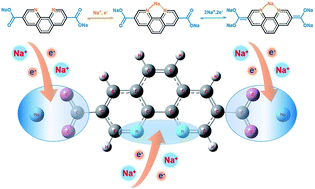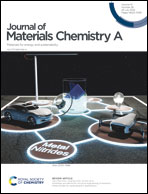Highly efficient phenanthroline-based organic anode materials with a three-electron redox mechanism†
Abstract
To date, the exploration of high-performance electrode materials for applications in sodium-ion batteries (SIBs) remains a big challenge in the rapid development of secondary batteries. Organic electrode materials with high specific capacity and structural diversity have broad research prospects. Although organic materials are often criticized due to their low conductivity, highly efficient organic electrode materials can still be realized through rational molecular engineering. Herein, we designed and synthesized a new compound, sodium 1,10-phenanthroline-3,8-dicarboxylate (S-PD), as the anode material for SIBs. Despite the relatively large conjugated structure and high molecular weight, the electronic conductivity is improved due to the expanded molecular conjugation. Moreover, it is noteworthy to mention that the N atoms on phenanthroline provide additional active sites for the Na+ storage, apart from the carboxylate that can store 2 Na+. As a result, the excellent diffusion ability, fast reaction kinetics, and stable S-PD/electrolyte interface confer a high discharge capacity of 252 mA h g−1 and a reversible capacity of 126 mA h g−1 after long-cycle tests at a current density of 2.0 C. Our study could provide new insights into the rational design of efficient organic electrode materials for SIBs.



 Please wait while we load your content...
Please wait while we load your content...